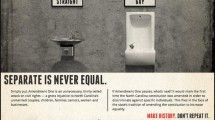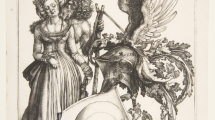Abstract
Two experiments are reported which investigate the factors that influence how persuaded mathematicians are by visual arguments. We demonstrate that if a visual argument is accompanied by a passage of text which describes the image, both research-active mathematicians and successful undergraduate mathematics students perceive it to be significantly more persuasive than if no text is given. We suggest that mathematicians’ epistemological concerns about supporting a claim using visual images are less prominent when the image is described in words. Finally we suggest that empirical studies can make a useful contribution to our understanding of mathematical practice.
Similar content being viewed by others
References
Alcock L., Weber K. (2005) Proof validation in real analysis: Inferring and checking warrants. Journal of Mathematical Behavior, 24: 125–134
Appiah K.A. (2008) Experiments in ethics. Harvard University Press, Cambridge, MA
Barwise J., Etchemendy J. (1991) Visual information and valid reasoning’. In: W. Zimmerman, Cunningham S.(eds) Visualisation in teaching and learning mathematics. MAA, Washington, DC, pp 9–24
Brown J.R. (1999) Philosophy of mathematics: As introduction to the world of proofs and pictures. Routledge, New York
Corfield D. (2003) Towards a philosophy of real mathematics. Cambridge University Press, Cambridge
Dove I. (2002) Can pictures prove? Logique et Analyse. 45(179–180): 309–340
Dreyfus T. (1994) Imagery and Reasoning in Mathematics and Mathematics Education. In: Robitalle D.F., Wheeler D.H., Kieran C.(eds) Selected lectures from the 7th International Congress on Mathematical Education. Les Presses de l’Université Laval, Quebec Canada, pp 107–122
Duffin J., Simpson A. (1993) Natural, Conflicting and Alien. Journal of Mathematical Behavior 12: 313–328
Dunbar K., Blanchette I. (2001) The in vivo / invitro approach to cognition: The case of analogy. Trends in Cognitive Science 5: 334–339
Dunbar K., Fugelsang J. (2005) Scientific thinking and reasoning. In: Holyoak K.J., Morrison R.(eds) Cambridge handbook of thinking and reasoning. Cambridge University Press, Cambridge, pp 705–726
Fugelsang J., Stein C., Green A., Dunbar K. (2004) Theory and data interactions of the scientific mind: Evidence from the molecular and the cognitive laboratory. Canadian Journal of Experimental Psychology 58: 132–141
Giaquinto M. (2007) Visual thinking in mathematics. Oxford University Press, Oxford
Gosling S.D., Vazire S., Srivastava S., John O.P. (2004) Should we trust web-based studies? A comparative analysis of six preconceptions about internet questionnaires. American Psychologist 59: 93–104
Hanna G., Sidoli N. (2007) Visualisation and proof: A brief survey of philosophical perspectives. ZDM Mathematics Education 39: 73–78
Harel G. (2007) Students’ proof schemes revisited: historical and epistemological considerations. In: Boero P.(eds) Theorems in school: From history, epistemology and cognition to classroom practice. Sense, Rotterdam, pp 65–78
Harel G., Sowder L. (1998) Students’ proof schemes: Results from exploratory studies. In: Schoenfeld A.H., Kaput J., Dubinsky E.(eds) Research in collegiate mathematics III. American Mathematical Society, Providence RI, pp 234–282
Harel G., Sowder L. (2007) Toward comprehensive perspectives on the learning and teaching of proof. In: Lester F.(eds) Second handbook of research on mathematics education. Information Age Pub Inc., Greenwich CT
Healy L., Hoyles C. (2000) A study of proof conceptions in algebra. Journal for Research in Mathematics Education 31(4): 396–428
Inglis M., Mejía-Ramos J.P. (2008) How persuaded are you? A typology of responses. Research in Mathematics Education 10(2): 119–133
Inglis, M., & Mejía-Ramos, J. P. (2009). The effect of authority on the persuasiveness of mathematical arguments. Cognition & Instruction (to appear).
Inglis M., Mejía-Ramos J.P., Simpson A. (2007) Modelling mathematical argumentation: The importance of qualification. Educational Studies in Mathematics 66: 3–21
Klauer K.C., Stahl C., Erdfelder E. (2007) The abstract selection task: New data and an almost comprehensive model. Journal of Experimental Psychology: Learning, Memory and Cognition 33(680–703): 33, 680–703
Littlewood J.E. (1953) A mathematician’s miscellany. Methuen, London
Mancosu, P., Jorgensen, K. F., & Pedersen, S. A. (Eds.), (2005). Visualization, explanation and reasoning styles in mathematics. Dordrecht, The Netherlands: Springer.
Martin W.G., Harel G. (1989) Proof frames of preservice elementary teachers. Journal for Research in Mathematics Education 20: 41–51
Nadelhoffer T., Nahmias E. (2007) The past and future of experimental philosophy. Philosophical Explorations 10: 123–149
Pinto M., Tall D.O. (2002) Building formal mathematics on visual imagery: A case study and a theory. For the Learning of Mathematics 22(1): 2–10
Raman M. (2002). Proof and justification in collegiate calculus. Ph.D. thesis, University of California, Berkeley.
Raman M. (2003) Key ideas: What are they and how can they help us understand how people view proof?. Educational Studies in Mathematics 52: 319–325
Recio A., Godino J. (2001) Institutional and personal meanings of mathematical proof. Educational Studies in Mathematics 48: 83–99
Reips U.-D. (2000) The web experiment method: Advantages, disadvantages, and solutions. In: Birnbaum M.H.(eds) Psychological experiments on the internet. Academic Press, San Diego, pp 89–117
Reips U.-D., Neuhaus C. (2002) WEXTOR: A web-based tool for generating and visualising experimental designs and procedures. Behavior Research Methods, Instruments and Computers 34: 234–240
Reips U.-D., Stieger S. (2004) Scientific Loganalzyer: A web-based tool for analyses of server log files in psychological research. Behavior Research Methods, Instruments and Computers 36: 304–311
Segal J. (2000) Learning about mathematical proof: Conviction and validity. Journal of Mathematical Behavior 18(2): 191–210
Selden A., Selden J. (2003) Validations of proofs considered as texts: Can undergraduates tell whether an argument proves a theorem?. Journal for Research in Mathematics Education 34(1): 4–36
Toulmin S. (1958) The uses of argument. Cambridge University Press, Cambridge
Van Kerkhove, B., Van Bendegem, J.P. (eds) (2006) Perspectives on mathematical practices: Bringing together philosophy of mathematics, sociology of mathematics, and mathematics education. Springer, Dordrecht
Vinner S. (1989) The avoidance of visual considerations in calculus students. Focus on Learning Problems in Mathematics 11: 149–155
Weber K. (2008) How mathematicians determine if an argument is a valid proof. Journal for Research in Mathematics Education 39: 431–459
Weber K., Alcock L. (2004) Semantic and syntactic proof productions. Educational Studies in Mathematics 56: 209–234
Author information
Authors and Affiliations
Corresponding author
Rights and permissions
About this article
Cite this article
Inglis, M., Mejía-Ramos, J.P. On the Persuasiveness of Visual Arguments in Mathematics. Found Sci 14, 97–110 (2009). https://doi.org/10.1007/s10699-008-9149-4
Published:
Issue Date:
DOI: https://doi.org/10.1007/s10699-008-9149-4




